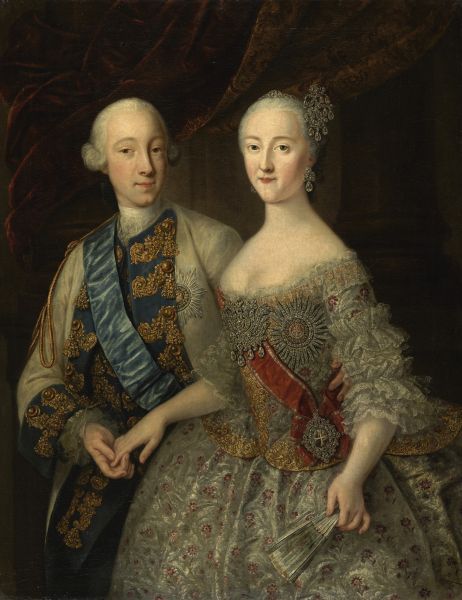|
|
Portrait of the Grand Duke Peter Fyodorovich and the Grand Duchess Catherine Alexeyevna

GROOTH Georg Christoph (?),
Oil on canvas
129 х 100
State Russian Museum
Annotation
Peter Feodorovich (1728–1762) was the son of Tsarevna Anna Petrovna and Duke Charles Frederick of Holstein-Gottorp; he was also the grandson of two implacable enemies, Emperor Peter the Great of Russia and King Charles XII of Sweden. He became heir to the Russian throne in 1742 and was Emperor from 25 December 1761 to 28 June 1762, but was never crowned. He imitated Peter the Great in intending to carry out a number of reforms. The Manifesto on the Freedom of the Nobility, the abolition of the Office for Secret Investigation and the secularisation of church lands formed the basis of the legislative measures subsequently taken by Catherine the Great. The view of traditional historiography is that he was ignorant and feeble-minded. He was overthrown by a palace coup instigated by his own wife, the future Catherine the Great, and was soon killed.
Empress Catherine II (the Great; 1729–1796), née Sophie Friederike Auguste von Anhalt-Zerbst-Dornburg, was born in the Prussian city of Stettin. In 1744, she arrived in Russia as the bride of Grand Duke Peter Feodorovich, the future Emperor Peter III. That same year, she converted to Russian Orthodoxy and took the name Catherine Alexeyevna. She married Peter Feodorovich in August 1745. In 1754 she gave birth to an heir, the future Emperor Paul I. The relationship with her husband did not work out, and he planned to have her sent to a convent. In the summer of 1762 she led a conspiracy of Peter’s guards and overthrew him, becoming Empress. In the first years of her reign she adhered to a policy of “enlightened absolutism”, but after the peasant rebellion led by Emelyan Pugachev (1773–1775) and the French Revolution (1789), she was forced to toughen her regime. She led victorious campaigns against Turkey (1768–1774; 1787–1792) and Sweden (1788–1790). During her reign, the Crimea (1783), the Northern Baltic Sea, the Baltic states, the eastern part of Poland, and the Aleutian Islands became part of Russia. Russian settlements were established in Alaska, and Eastern Georgia was taken under the protection of Russia. Russia’s prestige in Europe increased greatly.
Author's Biography
Grooth Georg Christoph
GROOTH Georg Christoph (1716, Stuttgart – 1749, Saint Petersburg)
German painter. Portraitist. He worked in Russia from 1740 (1?) to 1749. Since December 1743, the Keeper of the Palace art galleries. He also decorated the interiors of palaces and other buildings in St. Petersburg and Tsarskoe Selo. He created a whole gallery of portraits of the Russian aristocracy.

